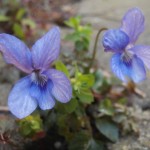
The Wildflower garden in February
Typically bitterly cold and wet with the strong possibility of snow and ice, February is the month that sees the first catkins begin to appear on Hazel, Goat willow and Alder trees. Look out for the first signs of spring with Celandines, Primroses, Sweet Violets, Snowdrops and Aconites appearing in woodlands and hedgerows. Wildlife is also starting to become more active this month. An increase in the volume of the dawn chorus is the first sign of resident birds gearing up for the oncoming breeding season. The first insects will appear in February drawn by the scent of early spring flowers. There is also a possibility of seeing early butterflies such as Commas or Brimstones. So far winter 2016 has been very mild, with Snowdrops and Daffodils flowering almost a month earlier than normal, but the timing of frogspawning seems unaffected and frogs and toads should soon emerge from hibernation. If you have a pond you will probably notice the first frogspawn appear at some stage during the month.
Later in the year, other wildlife such as dragonflies and damselflies can be attracted to garden ponds and wildlife pools by introducing native wetland plants in the spring. We have a wide range of wetland species in stock and available to order as seeds or plug plants through our website at www.wildflowersuk.com
If you have a good supply of fruit and berries in your garden, then you may be lucky enough to see Redwings and Fieldfares over the next few weeks. These winter thrushes from Scandinavia are usually found on farmland where they field on earthworms. When the ground freezes in harsh weather they will often visit wildlife gardens in search of wild fruit and berries.
Tasks and tips for this month
If you are planning on sowing a Wildflower Meadow this spring then now is the time to think about ground preparation. Ideally seed should be sown onto weed free soil in March or April and in readiness you should now spray off any existing vegetation. We have a wide range of Wildflower and meadow grass mixtures in stock to suit all soil types and situations. For further information please click here.
Meanwhile, if you sowed your meadow last season then it will soon be time to resume cutting in preparation for this year’s flowering. Maintain any grasses at a height of approximately three to four inches between now and May and afterwards remember to remove any loose cuttings. This will allow Wildflower seedlings to develop and establish and prevent them from becoming smothered by the more competitive grasses.